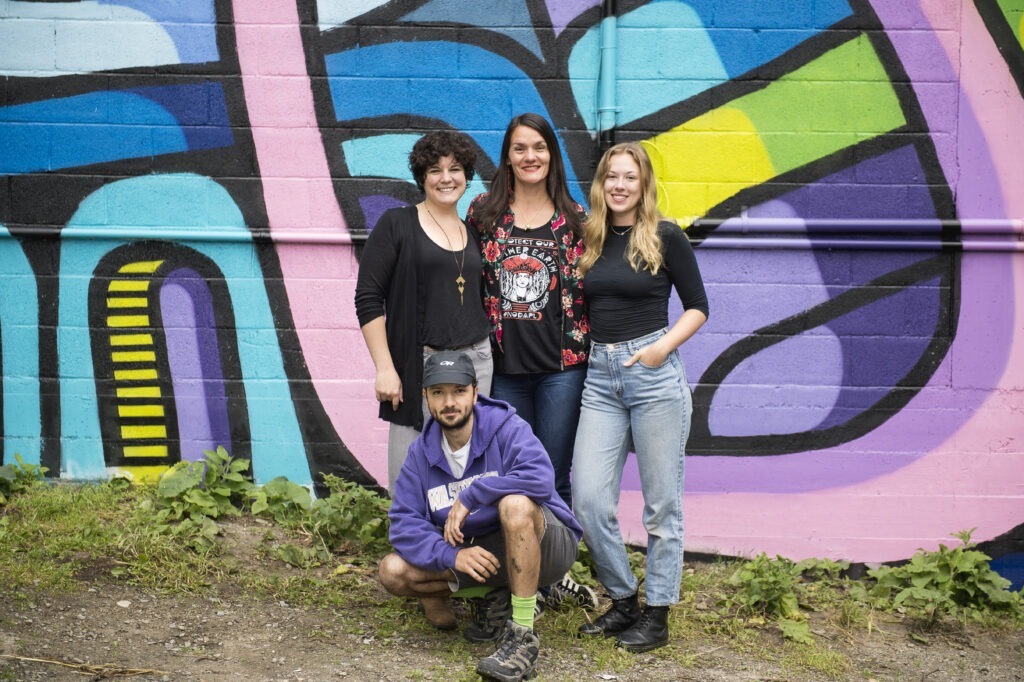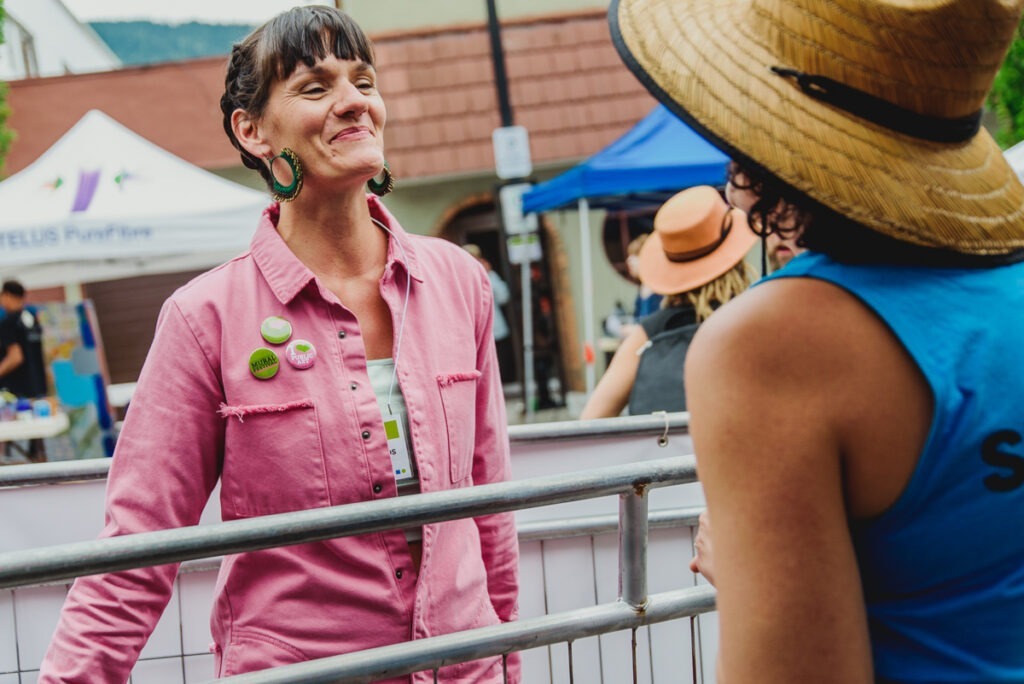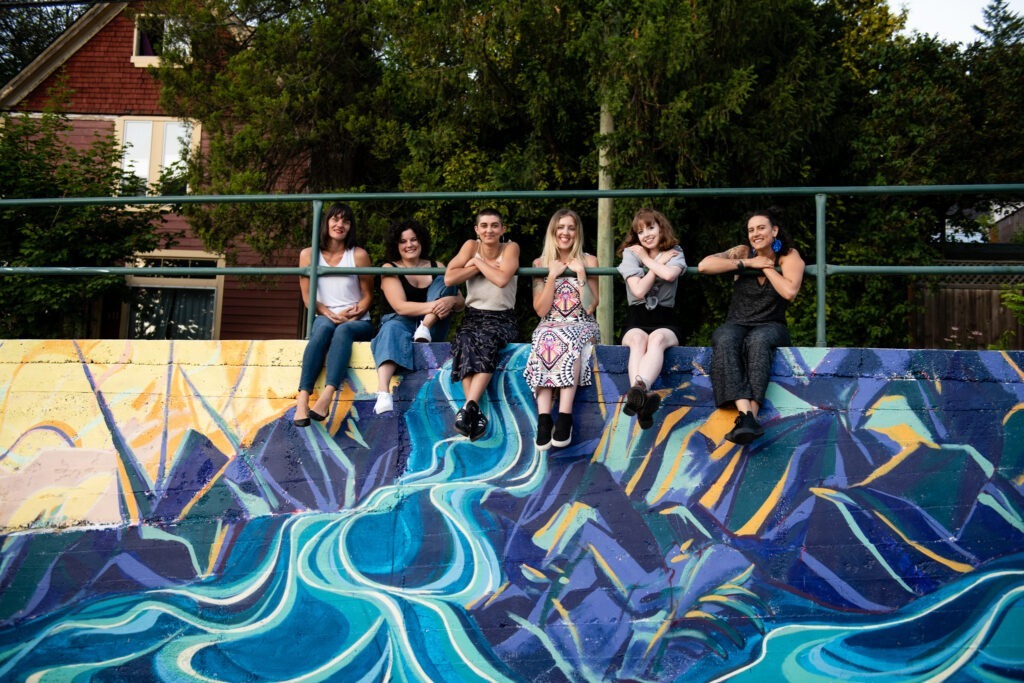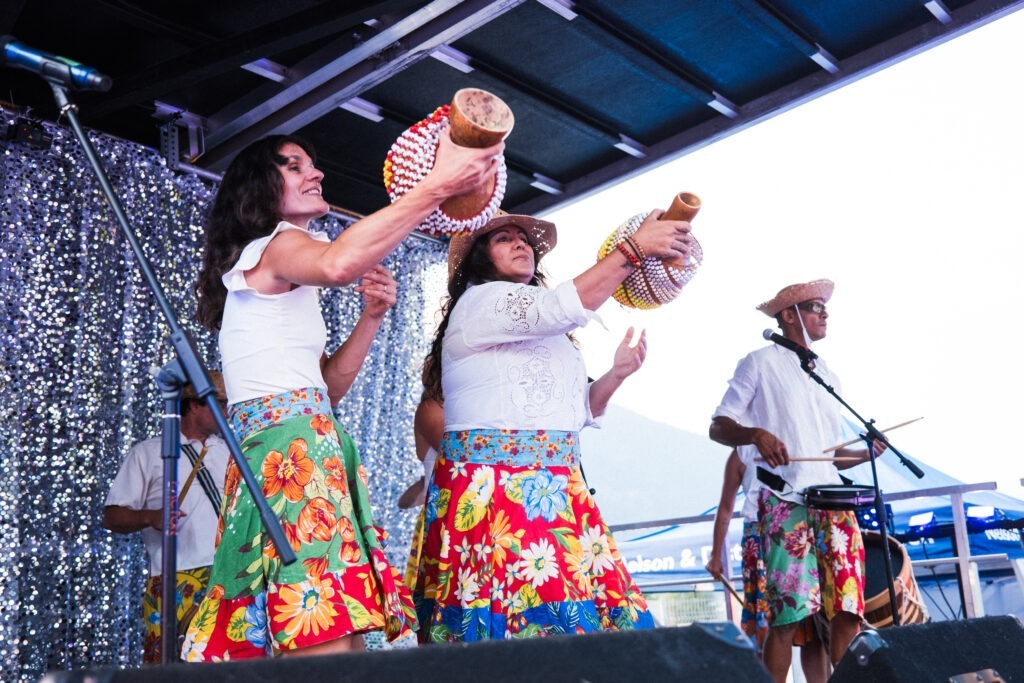Outgoing Nelson International Mural Festival Curator, Amber Santos, reflects on her 7 years of experience with the festival in this letter.
On Relationships
I’m extremely grateful for my experiences with the Nelson International Mural Festival as co-founder and for the last seven years in the role of curator. I’m really proud to be contracted by an organization that has evolved so much in the area of equity, reconciliation and accessibility. What I notice is that the Nelson District Arts Council is very responsive and works with the feedback from artists, staff and the community. I feel really grateful to be with an organization that is not afraid to have difficult conversations with people in order to make processes better and more meaningful.
We put a lot of care into our relationships with artists. And I feel like we’ve really tried to create a wonderful experience—where an artist is supported to do their best work—in a small rural town in the BC interior, amongst beautiful nature and a thriving art community. I really love that muralists have been able to connect with other muralists, jump in the lake on their breaks, meet locals, and feel appreciated by the community. Those relationships we’ve built are so important and I feel really proud of that.
That kind of weaves into the whole process of muralist applications for the festival. It’s very easy. It’s just a one-pager. We’ve worked really hard to try to make a container where the artists have as much freedom of expression as possible. We’ve supported artists who have never been here, in materials, conversations, and themes so that they can create something that feels relevant to the community and to the place. I think that’s all been really important along the way.

On Public Art
I feel really proud of occupying public space in this creative way. Art and culture are so important; they’re human rights. Public space should allow access to art and culture for the humans and communities that occupy it. Bringing murals into the public space, it’s art that is free, that could start a conversation, spark a different way of thinking, or create some kind of connection to your own personal experience. It can be spontaneous. When folks are looking at a piece of art, they’re bringing their own stories, they’re making their own connections, and it’s meaningful to people in different ways. There’s so much different art to look at right in the streets, especially in the downtown core, which is our public space, our civic space and a place where we’re meant to engage socially and culturally.

On Curation
Curation has been a shared pleasure, joy, privilege, and honour with co-founder Sydney Black. We worked really closely together, especially in those first years when our team was smaller. We were very mindful and thoughtful about the walls; we balanced the murals on public walls with the murals chosen by private building owners. We really thought about sparking conversation and dialogue, and the intention was to have a lot of different styles of art—always excellent muralists with a lot of experience—and really something for everyone. You might not love all the murals, but hopefully there’s an artwork that you can connect with.
I feel really proud that there are murals made by artists with many different lived-experiences and backgrounds. I think that’s really important, especially thinking about representation and looking at how our community has grown and changed over the past few years. So, I feel really happy about pieces like Sandeep Johal’s mural and all of the Indigenous murals—especially from the territories that are traditional to this land and the First Peoples of this land. I feel like that is a really beautiful, unique part of our collection of murals in the festival and outside of the festival as well—just murals in general in Nelson.
We’ve seen more than 900 applicants applying from all over the world, from every continent. That’s so amazing for our little festival. We can only do between six to ten-ish murals a year, so that’s a lot of applicants. Part of my gesture as curator was to go through the applications and reduce it to a list of 100 artists. I feel like my taste, my perspective, and my flavour was really in there, which is part of the reason why it was time for someone else to bring in a new point of view. Because while I tried to be quite objective … well for example, I’m not a big fan of realism, but I always included the best, the most interesting and the most original realists in my list, because we needed representation from all of the different artistic styles.
I was also thinking about who our community is, right? So, while our community is predominantly white/settler, I was still thinking about immigrant communities, and Indigenous communities. I was also thinking about diversity of styles. Everyone that I would put in the top 100 were excellent, professional, and had flawless execution. They came from a great array of backgrounds and lived-experiences. What really helped bring folks to the top of the list was originality. That’s what happened for me over these years of looking at (what felt like) every mural in the world. If I saw something unique, it really struck me because my eye was so trained from looking at everything. I would look at every single applicant and a lot of things started to look really the same—especially in realism. So, if I saw a realist combining their style with abstraction or they had something else that they were bringing to it other than just being good at executing a realist painting or mural, that artist would really rise to the top for me.
Of course, after I made my list of 100, then it would go to the jury and get rated. And next, there was still the choice from the building owners. And then we would work, Sydney and I together, with those top choices from the jury to then choose public walls to fit. We were always thinking about what our collection of murals already had. I feel very proud that we’ve been able to get past painting bears.

On the Community Response
What I noticed from the beginning of the festival, was the community really wanted to see what already existed reflected back at them. Almost as if they needed affirmation of where they were, who they were and who we are as a community. Before the festival started, when I worked on the mural at the Big Orange Bridge, we had a participatory process where the community could weigh in on themes. What we heard was that folks wanted to see bears, nature, skiing, hockey and other things that our community loves. They wanted to see these things reflected in the artwork. I think that was really just a process of beginning this mural collection in our community. And I see that we’ve evolved from that.
I think this desire comes from community really wanting to understand what the art is, but to not have to work too hard; they want it to be easy. They don’t want to be left out of the conversation. They don’t want to have to figure it out so much in the beginning. Now, we’re starting to get a little bit more into more conceptual types of work, very slowly. I think that’s really exciting and really interesting. I’m hoping that in the future we can bring in even more murals to help us figure out things, identify themes, issues, and ideas that are important to us in the community. A mural can be part of working out that conversation of who we are and where we want to go, especially in this moment in time.
I feel very proud of the murals that are already happening and really excited about the possibility of these murals provoking even more questions, dialogue, conversation, and connection in our community as the festival continues.

What was your favourite part of doing this role?
Calling the artists to tell them that they have been selected for the Nelson International Mural Festival. That was always fun. And hanging out with Sydney, Ingrid, and the rest of the team. Working with people, going to the walls, bringing artists coffee. I just love sitting and watching the wall evolve.

Moments from your time as curator that stand out to you?
Gosh, I have to dig pretty deep for those.
- I love the combination of the Hume mural and Sheldon Pierre Louis’s mural together, because they’re different perspectives on history; I thought it was really clever having them right next to each other.
- I loved Sandeep Johal learning how to use the big lift. I love seeing the artists working in totally unique and distinct ways every single time.
- I loved Timothy Robert Smith, who came from California, and brought a mural that he created in his studio on a roll of canvas and then pasted it to the wall.
- Or working with Andrew Tavukciyan. It was so cool because he’s a designer and that piece was kind of early in his mural experience.
- The folks, the Colour Dreamers, how they approach things.
- Katie Green, she was amazing. Her work was amazing. She used a lot of brushes. She had this whole process that was so beautiful.
- Cassie Suche’s work was so interesting. All her connection to math and geometry was really cool.
- And I definitely have a sweet spot for Jean-Paul Langlois’ work. I love his work. I’m Métis. He’s Métis. I felt really happy to have his work. He was a real character. A really big heart.
- I’m really glad that PJ Gilhuly came back and kept coming back. That made me feel really happy.
- I’m happy that we’ve got murals by some of the OG graffiti people. You know, we’ve got Bryn Stevenson, who I admire a lot. He’s been painting here for a long time. He’s a really wonderful artist, really wonderful person to work with.
- I feel super proud about that piece by Bacon, because Bacon is, such a graffiti legend. We owe a lot of our success as a mural festival to the history of graffiti in Canada. The oldest graffiti festival is in Montreal. It has a deep connection because it’s so close to New York as well. It was really cool to honour an old school graffiti artist who a lot of graffiti artists here really admire. It was so sweet how it played out, because he did a commission piece on one side and then the building owner loved it so much that she hired him to do the other side and he got to bust out a really sweet wild-style piece.
- Of course, Ric Gendron, I don’t know if he’s considered festival muralist, is he? I can’t remember. (Editors note, this mural isn’t part of the festival, but was commissioned separately though NDAC.) Anyways, I love his mural. It’s so special to have a mural by a Sinixt elder here. He has now passed away, so that makes it even more profound.
- I love, love, love Emma Noyes’ pieces. The first one at the Capitol Theatre wasn’t part of the festival, but that’s one mural I really enjoy. Her second one at Gyro Park was part of the festival. I think that one was really cool because it brought together a great group of volunteers and helpers. It was mainly a group of Indigenous women working together, which was really, really powerful.
- I also got to know some of the artists. For example, Dodo Ose was a very lovely character. I was able to have him over for a meal; he arrived and he came straight over to my house and I made him some lunch, lent him my bike, and he went for a bike ride. I hung out with him quite a bit at his wall when he was painting. We actually had some connections back in Montreal with some different painters. That was really nice. My kids got to meet him, and he and my husband hung out a bit. That was really, really cool.
- I also really love “Moonshadow” by NASARIMBA. That’s an example of a more abstract piece that has some different techniques, so we’re kind of moving away from bears, which was really cool.
- I love our local artists, like Jaymie Johnson. I love her piece, “Nocturnal natare”
- “Mountain Soul” is probably one of my favourite pieces from last year (2024). I feel like it really speaks to the youth. It’s just so gorgeous what Lidia Cao captured there, very graphic novel. I feel like the aesthetic is very youthful, very “now”. And I heard a couple of like teenagers be like, “That’s my favourite mural.”
- I really love Fatspatrol’s mural. I learned a lot from her. And I found that the perspective that she brought from where she lives, where she’s from, and all of her experiences as an artist, as a woman of colour, her background, and her culture was very interesting. I feel so passionate, happy, and proud that she is curating for us this year. It’s going to be so cool to see how she works with the curatorial role. I’m very excited to see what she brings and how she’s going to help grow our wonderful festival.

What’s next?
I’m growing my art business and I have a studio here that I’m turning into an artist residency. I’m looking to build my local community, build my business, build my art practice, and build my work with equity and accessibility. And in my art practice, I tap into my own cultures. On my dad’s side, Métis, Swampy Cree, Anishinaabekwe. And on my mom’s side, third generation post-war Germany, anti-fascist German. Yeah. That’s what I’m excited about. Be a mom. Be an artist. Be a human.
